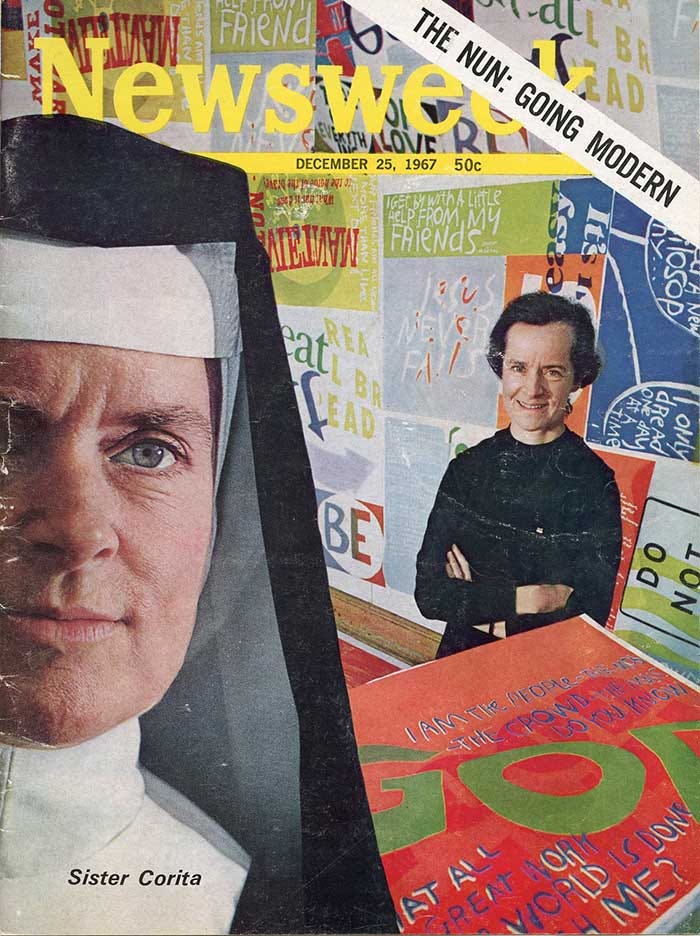About Corita

photo credit: Newsweek Magazine in Medium.
Weaving Together God and Social Justice through Art
Frances Elizabeth Kent was born in Fort Dodge, Iowa in 1918 to a profoundly Catholic family. After two siblings joined religious orders, Frances followed her sister Ruth’s footsteps and joined the Sisters of the Most Holy Immaculate Heart of the Blessed Virgin Mary in Los Angeles, California in 1936. When asked, “What is your motive for becoming a religious?” she replied, “Because it is my vocation” (Loste, 2000, p. 106). Frances Elizabeth Kent became Sister Corita.
“For many years Sister Corita was willing to submit to the wishes of her superiors. Sister Corita had been conditioned as a child to be strictly mindful of authority, but her faithful obedience did not outweigh her keen sense of curiosity” (Loste, 2000, p. 106).
After completing her Master’s degree in Art History from California State University in 1951, Corita began teaching art classes at Immaculate Heart College. It was here that Corita explored her religious and political expression through art, and passed on her wisdom and artistic skills to her students.
Corita’s artwork crossed many styles over the years, from expressionism, to abstract expressionism, to pop art, to social realism, and back again. Her selected media of printmaking and serigraphy was a political choice in itself:
“I’m a printmaker… a very democractic form, since it enables me to produce a quantity of original art for those who cannot afford to purchase high-priced art” (Corita quoted in Burlingham, 2013, p. 24).
While Corita’s earlier works were religious in theme, the influence of the social and political sphere in the United States and the world in the 1960s led Corita to incorporate into her work the themes of poverty, racial discrimination, war and peace, and controversies in the Church.
“Social justice was her way of expressing a religious experience… Her whole political thrust was probably the deepest religious feelings she had. She saw the need for justice and truth in society”
-Mickey Myers, student of Corita (Quoted in Loste, 2000, p. 109).
Corita’s prominence in the public eye and her political influence within the Sisters of Immaculate Heart did not always sit right with the greater Catholic religious community. Regardless, the Sisters, Corita included, made revolutionary changes as the work of the Second Vatican Council opened up participation of women in the Church and established an opposition to war.
“... [Cardinal McIntyre] wasn’t fond of Corita. He may have seen her as representing the faction of change”
-Corita’s sister, Sister Ruth (Quoted in Pacatte, 2017, p. 35).
It was this exploration into the world around her and commitment to peacebuilding that most influenced Corita’s students who went on to live her message in their own lives. After a colorful and fulfilling religious life and teaching career, Corita left her religious order and Immaculate Heart College in 1968, enjoying a retirement focused on art until her death in 1986.
References
Berry, I., & Duncan, M. (Eds.). (2013). Someday is now: The art of Corita Kent. The Frances Young Tang Teaching Museum and Art Gallery.
Burlingham, C. (2013). A very democratic form: Corita Kent as a printmaker. In I. Berry & M. Duncan (Eds.), Someday is now: The art of Corita Kent. The Frances Young Tang Teaching Museum and Art Gallery.
Loste, B.M. (2000). Life stories of artist Corita Kent (1918-1986): Her spirit, her art, the woman within. Bell & Howell Information and Learning Company.
Minneapolis Institute of Art. (2019, October 30). Sister Corita against the system: What activists can learn from a nun who melded Pop Art with protest in the 1960s. Medium. https://medium.com/minneapolis-institute-of-art/sister-corita-against-the-system-4aa2284b4c94
Pacatte, R. (2017). Corita Kent: Gentle revolutionary of the heart. Liturgical Press.

